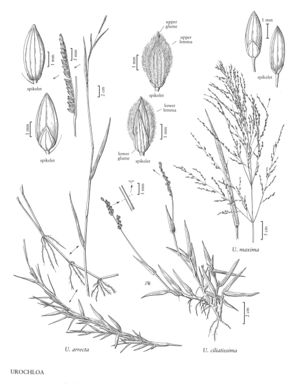Difference between revisions of "Urochloa arrecta"
FNA>Volume Importer |
GeoffLevin (talk | contribs) m (Corrected "Hack," to "Hack." in authority) |
||
| (5 intermediate revisions by 2 users not shown) | |||
| Line 1: | Line 1: | ||
{{Treatment/ID | {{Treatment/ID | ||
|accepted_name=Urochloa arrecta | |accepted_name=Urochloa arrecta | ||
| − | |accepted_authority=(Hack | + | |accepted_authority=(Hack. ex T. Durand & Schinz) Morrone & Zuloaga |
|publications= | |publications= | ||
|common_names=African signalgrass | |common_names=African signalgrass | ||
| + | |special_status={{Treatment/ID/Special_status | ||
| + | |code=I | ||
| + | |label=Introduced | ||
| + | }} | ||
|basionyms= | |basionyms= | ||
|synonyms= | |synonyms= | ||
| Line 17: | Line 21: | ||
-->{{Treatment/Body | -->{{Treatment/Body | ||
|distribution=Puerto Rico;Fla. | |distribution=Puerto Rico;Fla. | ||
| − | |discussion=<p>Urochloa arrecta is native to Africa, but it has been introduced into Florida and Brazil as a forage grass. It is reported to be established in Collier County, Florida.</p> | + | |discussion=<p><i>Urochloa arrecta</i> is native to Africa, but it has been introduced into Florida and Brazil as a forage grass. It is reported to be established in Collier County, Florida.</p> |
|tables= | |tables= | ||
|references= | |references= | ||
| Line 26: | Line 30: | ||
-->{{#Taxon: | -->{{#Taxon: | ||
name=Urochloa arrecta | name=Urochloa arrecta | ||
| − | + | |authority=(Hack. ex T. Durand & Schinz) Morrone & Zuloaga | |
| − | |authority=(Hack | ||
|rank=species | |rank=species | ||
|parent rank=genus | |parent rank=genus | ||
| Line 33: | Line 36: | ||
|basionyms= | |basionyms= | ||
|family=Poaceae | |family=Poaceae | ||
| − | |illustrator=Linda A. Vorobik | + | |illustrator=Linda A. Vorobik;Cindy Roché |
| + | |illustration copyright=Utah State University | ||
|distribution=Puerto Rico;Fla. | |distribution=Puerto Rico;Fla. | ||
|reference=None | |reference=None | ||
|publication title= | |publication title= | ||
|publication year= | |publication year= | ||
| − | |special status= | + | |special status=Introduced |
| − | |source xml=https:// | + | |source xml=https://bitbucket.org/aafc-mbb/fna-data-curation/src/200273ad09963decb8fc72550212de541d86569d/coarse_grained_fna_xml/V25/V25_1331.xml |
|subfamily=Poaceae subfam. Panicoideae | |subfamily=Poaceae subfam. Panicoideae | ||
|tribe=Poaceae tribe Paniceae | |tribe=Poaceae tribe Paniceae | ||
Latest revision as of 13:10, 1 December 2021
Plants perennial; stoloniferous. Culms 50-120 cm, branching and rooting at the lower nodes; nodes glabrous. Sheaths glabrous, margins ciliate; ligules about 1 mm; blades 5-15 cm long, 7-15 mm wide, glabrous, bases subcordate, margins scabrous. Panicles (5)9-18(25) cm long, 3-4 cm wide, with 4-10(15) spikelike primary branches in 2 ranks; primary branches (1)2-5(10) cm, axes 0.5-2 mm wide, glabrous, margins scabrous; secondary branches rarely present, pedicels shorter than the spikelets, mostly scabrous, apices with hairs. Spikelets (3)3.3-4.4 mm long, 1.4-1.7 mm wide, ellipsoid, solitary, imbricate, in 2 rows, appressed to the branches. Glumes scarcely separated; lower glumes 1.5-1.8 mm, glabrous, 5-veined, not clasping the base of the spikelets; upper glumes 3.4-4.1 mm, glabrous, 7-veined; lower florets staminate; lower lemmas 3.4-4.1 mm, glabrous, 5-veined; upper lemmas 2.7-3.5 mm long, 1.3-1.6 mm wide, apices rounded, incurved; anthers 1.6-1.8 mm. 2n = unknown.
Distribution
Puerto Rico, Fla.
Discussion
Urochloa arrecta is native to Africa, but it has been introduced into Florida and Brazil as a forage grass. It is reported to be established in Collier County, Florida.
Selected References
None.
